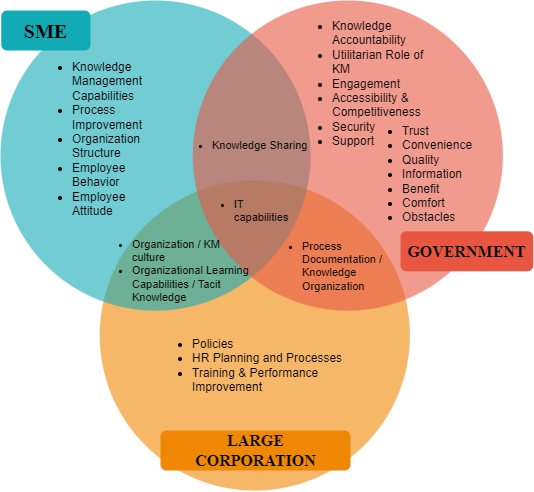
Factors influencing KMS adoption in SMEs, large, and government organizations
Establishing a knowledge management system (KMS) is an important aspect of organizational knowledge management (KM). This is reflected in the KM standard ISO 30401:2018 Knowledge management systems – Requirements and also David Williams’ Components of a knowledge management system which is the most-viewed article in RealKM Magazine.
Organizations have different sizes, from small and medium enterprises (SMEs) with often just a handful of staff and a limited budget, through to large corporations with thousands of employees and a turnover in the millions or even billions. Organizations also have different responsibilities in regard to the management of knowledge, for example keeping classified information secure can be an important priority for a government organization, but not for a mom and pop SME.
All organizations can potentially benefit from a KMS, but one of the shortcomings of ISO 30401 is that it takes a one-size-fits-all approach, and that size is “large.” ISO 30401 specifies requirements that are relevant to the capacity, capabilities, and responsibilities of large organizations, including to some degree government organizations, but that would be incredibly onerous and overwhelming for many SMEs. This reality is acknowledged in the RealKM Magazine series KM in small & medium enterprises (SMEs) which presents a range of research-based guidance that is directly relevant to KMS adoption in SMEs.
A newly published paper1 in the journal Information Management and Business Review complements that research-based guidance by identifying the factors that variously influence KMS adoption in SMEs, large organizations, and government organizations. To do this, the paper authors carried out a systematic review using the PRISMA guidelines2.
The results of the systematic review are summarized in the Venn diagram in Figure 1. These results are drawn from just six studies that met the systematic review eligibility criteria, and all six studies involved surveys which is generally a weak research methodology. Despite these limitations, the factors listed in the Venn diagram nevertheless provide a useful start point for a KMS in each of the different types of organization, and also suggest potential areas for further research.

Header image source and license: Created with factory, government, and store clipart from Clipart Library, CC BY-NC-ND 4.0.
References:
- Ariffin, S. N. F. S., Abidin, N. Z., Rosly, M. A., & Saihani, S. B. (2023). Factors Inducing the Adoption of Knowledge Management System (KMS) In SMEs, Large and Government Organizations. What Are the Intercepting Factors? A Systematic Review. Information Management and Business Review, 15(1), 140-148. ↩
- Moher, D., Liberati, A., Tetzlaff, J., Altman, D.G., & Prisma Group. (2009). Preferred reporting items for systematic reviews and meta-analyses: the PRISMA statement. PLoS medicine, 6(7), e1000097. ↩





